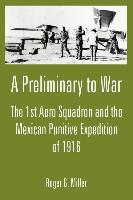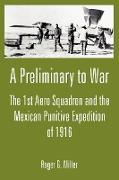- Start
- A Preliminary to War
A Preliminary to War
Angebote / Angebote:
On March 15, 1916, the 1st Aero Squadron arrived at Columbus, New Mexico, its train steaming into the crowded, chaotic town at 9:15 in the morning. Led by Capt. Benjamin D. Foulois, a lantern-jawed, bantam-weight former enlisted man, the squadron included eleven officers, eighty-two enlisted men, and one civilian technician. Under Foulois's direction, the men unloaded an automobile, six motorcycles, and twelve motor trucks, vehicles rare in 1916 New Mexico and even rarer in an army still wedded to the horse and mule. These were followed by wooden crates containing eight wood, wire, and fabric Curtiss JN--3 biplanes, every airplane owned by the U.S. Army, save those assigned to its aviation school at San Diego, California. The squadron was in Columbus to join an expedition commanded by Brig. Gen. John J. "Black Jack" Pershing. President Woodrow Wilson had ordered Pershing's force into Mexico in response to a March 9 attack on the tiny border town by the Mexican desperado, Francisco "Pancho" Villa. The event was auspicious. For the first time, the U.S. Army's entire air force---the 1st Aero Squadron---had deployed for an active campaign. The 1st Aero Squadron played a significant role in the Punitive Expedition, but, in dramatic contrast to how an air force functions today, it served as a means of communication and observation, not as a combatant arm. Some experiments with bombs and machine guns had been conducted, and the war in Europe was quickly turning the airplane into a serious weapon of war. Nevertheless, U.S. Army leaders envisioned aviation's primary mission to be the receipt and transmission of information for tactical commanders and long-distance scouting as an adjunct to the cavalry. Accordingly, during the mobile phase of the Punitive Expedition, the 1st Aero Squadron enabled Pershing to locate and communicate with his widely dispersed, fast-moving columns and carried dispatches between Pershing's main and advanced bases. The squadron also scouted for hostile forces and kept a watch for threats to Pershing's line of communications. As will be seen, these efforts were made in some of the worst weather and poorest conditions imaginable, and by the end of April, all eight airplanes had been destroyed. During the static phase of the Punitive Expedition, the 1st Aero Squadron remained at Columbus, where Foulois and his men operated a test and evaluation program for a wide variety of airplanes and aviation equipment. During both phases of the campaign, the officers and men of the 1st Aero Squadron learned lessons about airplanes, equipment, and operations in the field that would be applied in France less than a year later.
Folgt in ca. 10 Arbeitstagen

